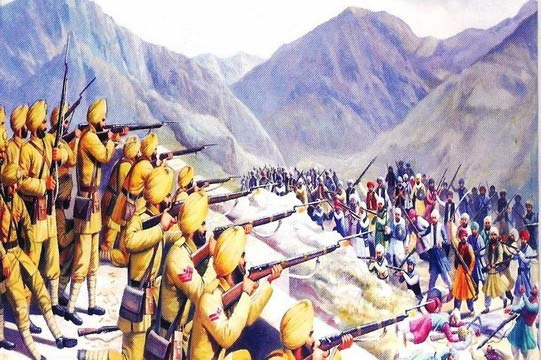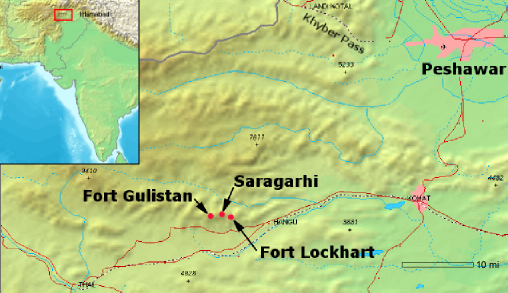Historic Battle of Saragarhi on 9/12; the Pride of Sikh Martyrs
 By Krishan Gupta
By Krishan Gupta
HOUSTON: Saragarhi Battle is an incredible history of 21 brave men of the 36th Sikh Regiment, born in the Majha region of Punjab who gave up their lives in devotion to their duty on September 12, 1897. In keeping with the tradition of the Indian Army, they fought to death rather than surrender.
The Battle of Saragarhi is one of eight stories of collective bravery published by UNESCO, and mentioned as one of the five most significant events of its kind in the world which includes the Saga of Thermopylae associated with the heroic stand of a small Greek force against the mighty Persian Army of Xerxes in 480 B.C.
Most of the forts in the Northwest Region were initially built by Maharaja Ranjit Singh and later on the British colonial rulers added more to provide security to troops against marauding tribesmen and their Lashkar’s. Saragarhi Post was located between Lockhart and Gulistan to provide heliographic communications between them. This picket had been fortified to provide safety and protection to the signalling detachment.
In 1897 there was a general uprising in the NWFP engineered by Afghans as part of their policy, which came to be known as the “prickly heat policy’ to direct the wrath of the tribal against the British.
The Commanding Officer of 36th Sikh Regiment, Lt. Col. Haughton, was at Fort Lockhart and was in communication with the Saragarhi post through helicograph. The defenders of Saragarhi under the indomitable and inspiring leadership of their detachment commander, Havildar Ishar Singh, resolved to defend their post in the best tradition of their race and regiment. He and his men knew well that the post would fall, because a handful of men in that make-shift fort of stones and mud walls with a wooden door could not stand the onslaught of thousands of tribesmen.

They fought back valiantly. For quite some time, the troops held their own against the determined and repeated attacks by the wild and ferocious hordes. The enemy suffered heavy casualties during this fight. Unmindful of his safety, Sepoy Gurmukh Singh kept signalling a minute-to-minute account of the battle from the signal tower in the post to Battalion HQs.
When repeated attacks failed, the enemy set fire to the surrounding areas and managed to close in with the post’s boundary wall and rifle fire from the post holes and succeeded to breach in the wall.
One of Havildar Ishar Singh’s men who was seriously wounded and bleeding profusely, took charge of the guardroom. He shot four of the enemy as they tried to approach his charge. The battle had come too close for Gurmukh Singh’s comfort, so he asked Battalion HQs for permission to shut down the heliograph and take up his rifle. He dismounted his heliograph equipment, and joined the fight. He took 20 of the enemy with him before he died. The post was recaptured two days later by another British Indian contingent.
This episode when narrated in the British Parliament drew from the members a standing ovation in the memory of the defenders. The story of the heroic deeds of these men was also placed before Queen Victoria. The account was received all over the world with full admiration. All the 21 valiant men of this epic battle were awarded the Indian Order of Merit Class III (posthumously) which at the time was one of the highest gallantry awards (Vir Chakra) given to Indian troops. All dependants of the heroes were awarded land and money. It is indeed a singularly unique action in Indian military history.
The Sikh Regiment celebrates the day of the Battle of Saragarhi each 12 September in their honor. Two Saragarhi Gurudwaras: one in Amritsar and one in Ferozepur Cantonment were built.
In 2010, the British and Indian armies’ polo teams commemorated the battle by holding the Saragarhi Challenge and raising thousands of pounds for the British Asian Trust.
